Microsoft Surface 2 Review
by Anand Lal Shimpi on October 21, 2013 12:00 AM EST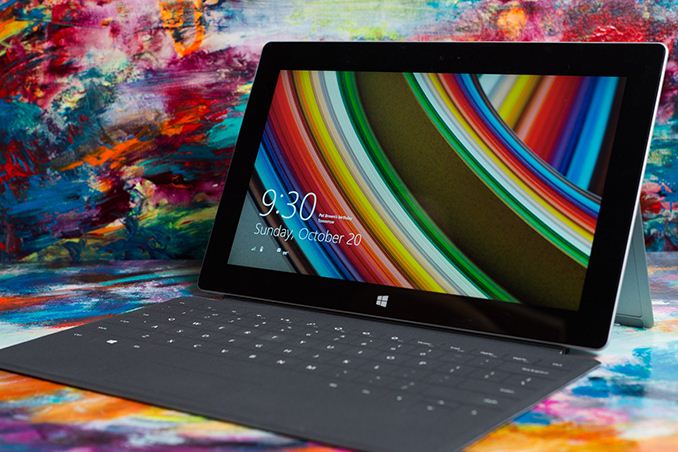
A year ago Microsoft first threw its hat into the tablet race with a new brand, a new OS and a completely new strategy. To make a challenging situation even more difficult, Microsoft chose to go after the traditional tablet market with a device that was neither a tablet nor a notebook.
I was relatively pleased with both Surface devices that launched last year. Surface RT had potential, but it was too slow, needed a price adjustment and of course needed more maturity on the OS side. Surface Pro on the other hand needed to be thinner, needed Haswell and related, it needed better battery life.
With its new commitment to being a devices & services company, Microsoft now joins the ranks of Apple and Google in shipping platforms with annual updates to hardware and software. Last week we saw the software side of the story, with a free update to Windows 8.1. It wasn’t too long ago that Microsoft was charging hundreds of dollars for new OS revisions, but with Apple and Google redefining what users come to expect from both cost and frequency of OS updates, Microsoft had to change.
Today we get the second half of the story. Microsoft’s partners have already announced their Windows 8.1 launch devices, now it’s time for Microsoft.
I’ll start with Surface 2, which sees the largest number of physical changes compared to its predecessor. It’s still built using the same injection molded magnesium manufacturing process (VaporMg, pronounced vapor mag), but moves to a 2-piece VaporMg design similar to Surface Pro. There’s the VaporMg tub and the kickstand.
The look and feel of the device see substantial updates. The finish of Surface 2 is now a light silver. Not only does the new finish not pick up grease/fingerprints like the previous black finish, but it also has a slightly more textured feel to it. Staring at Surface 2’s display head on you get a little bit of a silver border around the display, a nice touch. Surface 2’s construction feels every bit as solid and expensive as its predecessor. Both devices remain the absolute best built Windows tablets/notebooks on the market.
Curiously enough both Surface 2 and Surface Pro 2 ditch the Windows 8 logo on the back of the kickstand in favor of a Surface logo. The devices in general continue to be devoid of excess branding. Both have a capacitive Windows button up front, the aforementioned Surface logo around back and some branding on their respective chargers. There are no stickers to remove, and no COA labels to worry about. It may be years later than we’d hoped, but Microsoft finally gets the beauty of clean aesthetics.
The overall dimensions of Surface 2 don’t change much compared to its predecessor. We’re still dealing with the same 10.6-inch display size, although it sees an update to a 1080p panel with improved color accuracy. The panel size determines the overall device footprint, which explains why that doesn’t change this round. Thickness goes down a small amount from 0.37-inches to 0.35. The reduction is very subtle but helps contribute to the device feeling more right in hand.
Weight improves slightly if you compare Surface 2 to Surface RT. While the latter weighed in at 1.5 lbs, Microsoft lists Surface 2 as weighing less than 1.49 lbs. The somewhat vague spec is designed to take into account variations in manufacturing. Microsoft encouraged me to weigh my Surface 2 review sample, which came in at 1.45 lbs compared to a flat 1.50 lbs for Surface RT. It’s a small difference, but a definite step in the right direction. If the rumors of a lighter iPad 5 are true however, I do wonder if Microsoft should’ve been a bit more aggressive on the weight reduction front this round.
Just as before, Microsoft stresses the importance of looking at weight distribution not just overall weight specifications. Truth be told, Surface 2 doesn’t feel as heavy as the iPad despite having very similar weight specs.
A big part of the Surface story is the device’s integrated kickstand. The best way to talk about the improvements to the kickstand in Surface 2 (and Surface Pro 2) is to quote what I said about the previous design:
“The more I use Surface (Pro and RT) the more I feel that Microsoft needs to pursue something a bit more flexible than the fixed 26-degree kickstand. The biggest issue by far is in-lap use with one of the keyboard covers attached. Depending on your seating position, the 26-degree angle that the kickstand opens at might be too small. Mechanically I don’t know the right solution for Microsoft but I do feel like for the kickstand to realize its true potential, it needs to be able to open and hold at multiple angles. It doesn’t necessarily need to have support for infinite angles, maybe even a few would work, but I do believe it’s necessary going forward.”
Well, wouldn’t you know, Microsoft listened. Surface 2 and Surface Pro 2 both feature a new, 2-stage kickstand. You still get the same solid action, same sound and even the same 24-degree opening angle, but now there’s a second stop in the kickstand’s travel at 40-degrees. The 2-stage design almost completely addresses my issues with the first generation of Surface tablets. While the 24-degree stop is perfect for desk use, the 40-degree stop is ideal for in-lap use. The second stop keeps me from having to strain my neck looking down at the display when I’m typing in cramped quarters (e.g. having to type out this review in the back of a car heading to an airport).
Moving between stops on the new kickstand feels natural, and the new kickstand feels every bit as robust as its predecessor.
I don’t know that Microsoft has perfected the design though. I could still use another stop (or two). Perhaps one at 15-degrees for the on-chest use case if I’m laying down with the tablet on my chest watching a movie. A real issue created by the 40-degree stop is now I need even more leg/thigh/lap-space to support the device. Since there’s no support to hold the display up until you get to the kickstand, you need to make sure that the kickstand has a place to rest when open at its widest angle. I don’t know the right mechanical solution to this concern, but I still feel like Microsoft has some more work ahead of it on the kickstand front.
Behind the kickstand is a repositioned microSD card slot. It’s now further away from the kickstand hinge.
The ports/buttons around the edges of Surface 2 haven’t really changed compared to Surface RT. On the left you’ll find volume up/down buttons (which are appreciably clickier compared to my Surface RT review sample), a headphone jack and one of two speaker ports. On the top right there’s a power/lock button. On the right side you’ll find the other speaker port, micro HDMI output and a USB 3.0 port (new for Surface 2, RT only supported USB 2.0). All of the Surface devices retain the same custom, magnetic power connector as before.
Along the bottom there’s a slightly updated accessory connector and channel for accepting Surface’s famed keyboard covers, as well as new accessories this round. All first generation Surface accessories are supported.
Both front and rear facing cameras get a big upgrade with Surface 2. Surface RT shipped with two 1.2MP cameras, while Surface 2 moves to a 3.5MP front facing camera and a 5MP rear facing camera.
Internally, the upgrades are even more substantial. NVIDIA’s Tegra 3 is out of the picture, replaced by a far faster Tegra 4 SoC. That’s four ARM Cortex A15 cores running at up to 1.7GHz (1.9GHz with only one core active), as well as a fifth power saver core that actually sees some use this time (more on this later).
WiFi remains dual-band 2-stream 802.11n on both Surface 2 and Surface Pro 2, although whatever peak performance issues plagued me on Surface RT seem to be resolved (I could hit 120Mbps max transfers over 5GHz 802.11n).
The tablet still ships with 2GB of memory, but now leverages a 64-bit wide memory interface. On the storage side the options are still 32GB or 64GB of eMMC.
| Microsoft Surface 2/RT Comparison | ||||||||
| Surface 2 | Surface RT | |||||||
| Dimensions | 10.81 x 6.79 x 0.35" | 10.81 x 6.77 x 0.37" | ||||||
| Display | 10.6-inch 1920 x 1080 w/ Improved Color Accuracy | 10.6-inch 1366 x 768 PLS | ||||||
| Weight | Less than 1.49 lbs | 1.5 lbs | ||||||
| Processor | NVIDIA Tegra 4 1.7GHz | NVIDIA Tegra 3 | ||||||
| Connectivity | 802.11n WiFi | 802.11n WiFi | ||||||
| Camera | 3.5MP front facing, 5MP rear facing | 1.2MP front facing, 1.2MP rear facing | ||||||
| Memory | 2GB | 2GB | ||||||
| Storage | 32GB or 64GB eMMC | 32GB or 64GB | ||||||
| Battery | 31.5 Wh | 31.5 Wh | ||||||
| Starting Price | $449 | $349 | ||||||
Battery capacity is still 31.5Wh and Surface 2 still ships with a 24W charger. Surface 2 will draw 10W at the wall while charging, the over-specced adapter is designed to be able to power the system at full load without impacting charge times.
On the software front, Surface 2 ships with Windows RT 8.1 and a full copy of Office 2013 RT Home & Student Edition. Pricing starts at $449 for a 32GB model, or $549 for the 64GB version. Touch and Type covers continue to be sold separately at $119 and $129, respectively.


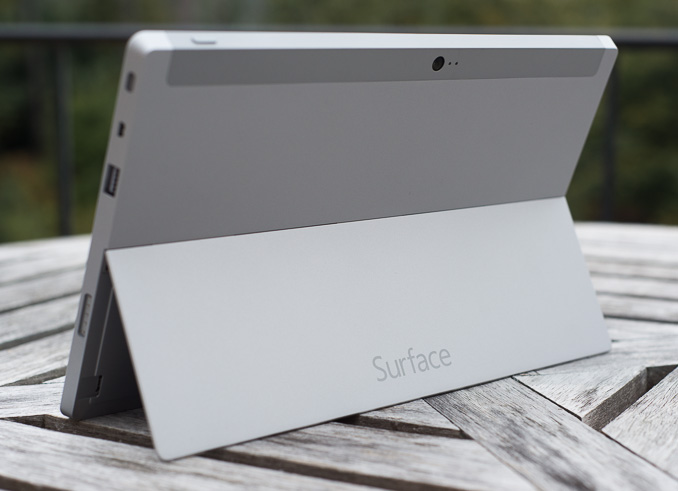
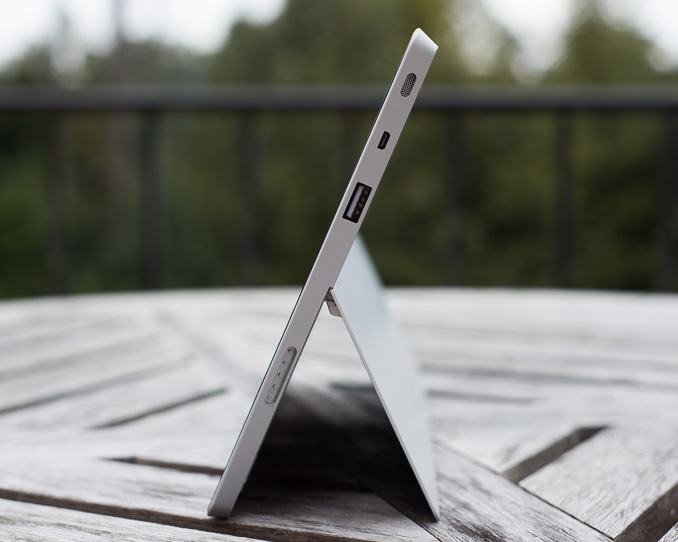
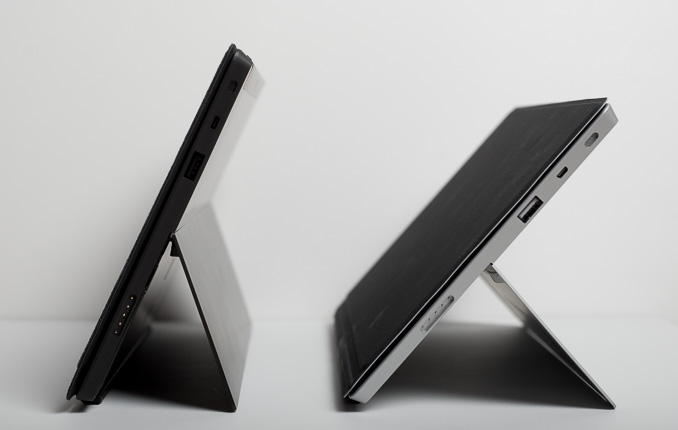
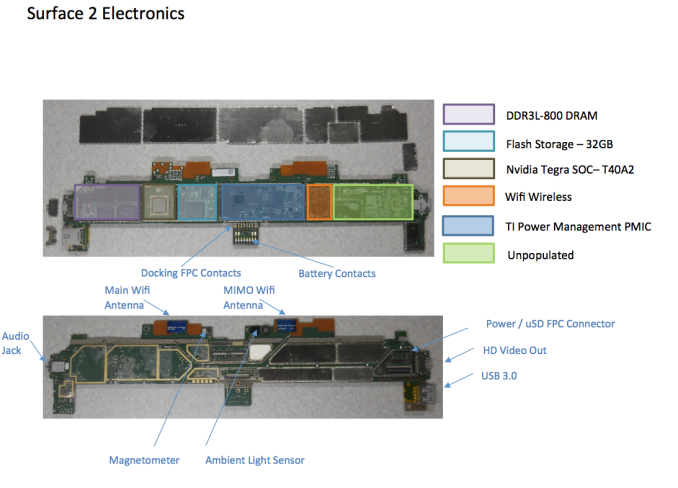








139 Comments
View All Comments
trip1ex - Monday, October 21, 2013 - link
Eh I don't see people clamoring for small tablet screen with a mediocre keyboard just so they can use Office. I don't see people wanting Windows on their tablet either. They want to ditch Windows as much they want to ditch the cable company.I think tablets are misunderstood my most still.
kyuu - Monday, October 21, 2013 - link
You're right: tablets are misunderstood by most. Apple and Google have fooled people into thinking tablets should be oversized smartphones. Microsoft instead presents WinRT, which offers much more functionality than iOS or Android, and all people can focus on is the app store selection, which is the one and only point iOS and Android have over WinRT.DocForker - Monday, October 21, 2013 - link
I love my gen 1 surface RT with 8.1 and can't wait for the Surface 2! I run apps side by side - the new Facebook is great, or I can have twitter in one panel and browse the web in the other half. OneNote that syncs between my phone, my wifes phone and my surface and my home and work desktops is amazing. Being able to edit a Word doc on my desk and then have it show up immediately in my recent list of Office Docs on the surface is awesome. Sending YouTube video (or streaming audio) from an IE browser window (using the devices charm) to my XBOX and having it play full screen high definition on my 60" plasma - all while browsing Facebook or reading the news and tracking Twitter is just something I don't think you can do anyplace else. What about playing Halo Spartan Assault on the surface and then sending it to the TV - and hooking up an XBOX controller and a Bluetooth headset. Or hooking up an external monitor with Word & Excel running on it - giving that to a person with wireless keyboard & mouse to work homework on and then having a second person playing a touch game wordament on the surface itself? Try that on an iPad or Chromebook or android tablet.I think the problems with most of these reviewers is that they just don't know what these devices are capable of. They are so locked in to a restrictive IOS ecosystem that they fail to see the possibilities with these Surface tablets.
http://s188.photobucket.com/albums/z258/tlforker/?...
http://s188.photobucket.com/albums/z258/tlforker/?...
InspectHerGadget - Tuesday, October 22, 2013 - link
You hit the nail on the head but then the restrictive iOS system does all they want so obviously they're not going out to buy an XBOX, a Windows 8 Desktop, a Windows 8 Phone then a Surface and then learn to tie it all together when they probably have AppleTV, iPad, iPhone and possibly a Mac in the house. Once you get into an ecosystem then I would say it really doesn't matter which one it is. iOS has a huge head start in this area so Microsoft have to pull out the stops to catch up and it isn't easy to get people to switch if they're happy with what they've got.ElBurro - Monday, October 21, 2013 - link
"but there’s still no good Twitter client, no amazing IM client, and of course you don’t get good integration of Google services anywhere (outside of leveraging Mail for Gmail access)."I hope you realize that in Microsoft is trying to eliminate the desktop especially for ARM. There is not much chance of the Win32 API opening up. In fact for it maybe shut down completely for Windows 10 or Windows 11 even for the pro versions of the OS.
ElBurro - Monday, October 21, 2013 - link
oops sorry I meant to put this quote"but I can’t see a future where Windows RT is successful and Microsoft doesn’t allow developers to access both sides of the platform
Death666Angel - Tuesday, October 22, 2013 - link
"It wasn’t too long ago that Microsoft was charging hundreds of dollars for new OS revisions, but with Apple and Google redefining what users come to expect from both cost and frequency of OS updates, Microsoft had to change."Isn't 8.1 more of a service pack than a new OS revision? And MS has never charged for those.
lilmoe - Tuesday, October 22, 2013 - link
Funny how much lower fps we're getting in the offscreen tests knowing that both are rendered at 1080p... Says a lot about the reliability of that benchmark. What's that overhead from?Tarrant64 - Tuesday, October 22, 2013 - link
There were statements about a new 2nd-gen charge for the Surface 2 but I have yet to see any pictures of what those changes are. It seems everything else was covered but it was hyped briefly that it would be worth buying. I'm curious if it is, because I hate my current charger. Any chance the article(s) can be updated to show the specific changes there?bull2760 - Wednesday, October 23, 2013 - link
Just purchased my Surface 2 and LOVE IT! I did previously own the 1st gen Surface RT but I sold it on Graigs list when I saw this one being released. 2nd generation is much faster at loading everying thing. Almost as fast as you click them the office suite apps open, big difference right off the bat between the 1st gen. Now that it includes Outlook you really can't beat this device for easy travel allowing you to take your work along with you. The new back lit TYPE keyboard is awesome. Way more responsive than the touch keyboard I sold with my old RT. I added a sandisk 64GB microSD and now I have 128GB of storage built in. I carry this around with me in the office as I work on employee computers so that I can answer email on the fly. Could not be happier with the purchase absolutely love the new Surface 2.